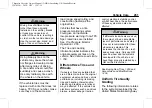
Chevrolet Corvette Owner Manual (GMNA-Localizing-U.S./Canada/Mexico-
12470550) - 2020 - CRC - 12/17/19
Vehicle Care
247
When driving on a deflated run-flat
tire, avoid potholes and other road
hazards that could damage the tire
and/or wheel beyond repair. When a
tire has been damaged, or if driven
any distance while deflated, check
with an authorized run-flat tire
service center to determine whether
the tire can be repaired or should be
replaced. To maintain the run-flat
feature, all replacement tires must
be run-flat tires.
To locate the nearest GM or run-flat
servicing facility, call Customer
Assistance.
Low-Profile Tires
Low-Profile Performance Tires
Caution
If the vehicle has 245/35ZR19
and 305/30ZR20 size tires, they
are classified as low-profile
performance tires. Low-profile
tires are more susceptible to
damage from road hazards or
(Continued)
Caution (Continued)
curb impact than standard profile
tires. Tire and/or wheel assembly
damage can occur when coming
into contact with road hazards like
potholes, or sharp edged objects,
or when sliding into a curb. The
warranty does not cover this type
of damage. Keep tires set to the
correct inflation pressure and
when possible, avoid contact with
curbs, potholes, and other road
hazards.
Summer Tires
High Performance Summer Tires
This vehicle may come with
245/35ZR19 and 305/30ZR20 high
performance summer tires. These
tires have a special tread and
compound that are optimized for
maximum dry and wet road
performance. This special tread and
compound will have decreased
performance in cold climates, and
on ice and snow. It is recommended
that winter tires be installed on the
vehicle if frequent driving at
temperatures below approximately
5 °C (40 °F) or on ice or snow
covered roads is expected. See
Caution
High performance summer tires
have rubber compounds that lose
flexibility and may develop
surface cracks in the tread area
at temperatures below
−
7 °C
(20 °F). Always store high
performance summer tires
indoors and at temperatures
above
−
7 °C (20 °F) when not in
use. If the tires have been
subjected to
−
7 °C (20 °F) or less,
let them warm up in a heated
space to at least 5 °C (40 °F) for
24 hours or more before being
installed or driving a vehicle on
which they are installed. Do not
apply heat or blow heated air
(Continued)
















































